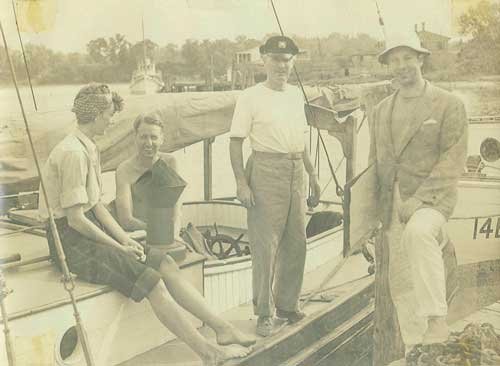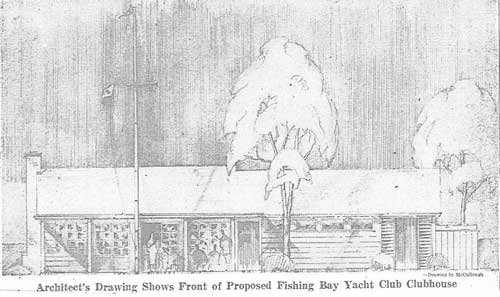From UYC to FBYC
![]()

by Jere Dennison
It was 1946, and the War had ended. The young Urbanna Yacht Club (UYC) had survived the critical early years of its existence at a leased location with an active racing program still intact. Members were returning from the military, and the post-war economic boom was about to commence. UYC was ready for a permanent home on Urbanna Creek to accommodate the expected higher levels of membership and activity. There was just one problem...no property was available for purchase.
According to one of our long-time members who was involved with UYC during the 1940s, we are indeed fortunate not to have a picture of what served as the original clubhouse: a rented shack (since demolished) with attached bathroom located within the vicinity of the present-day site of Doziers Marina. Efforts to acquire land for a proper facility with slips and launching area were futile. None of the owners of prospective sites were willing to sell. Interestingly, a portion of the Rosegill property on Urbanna Creek was a prime candidate, but the then owner of that local landmark did not follow through with a commitment to sell once the War had ended.
Accordingly, in February 1946, Commodore James Scott initiated an effort that would culminate in the relocation of UYC to its present site on Fishing Bay three years later. A site committee comprised of Reid Dunn, Allan McCullough, Marshall Moseley, Rucker Ryland, and Carroll Chowning conducted a comprehensive survey of eastern Virginia waters before submitting their recommendations to the Board.
 |
| Alice and James Scott (Commodore 1946) on Urbanna Creek in 1945 with Day Lowry (Commodore 1944 & 45) and Mac Wellford (Club Founder) |
Apparently the preferred site on Fishing Bay was not greeted by everyone with immediate enthusiasm. After all, Urbanna was an established town of historical note with necessary housing, services, and facilities and offering an excellent port with convenient access to the Rappahannock River. Deltaville, on the other hand, was still considered a backwater, 15 miles farther down narrow country roads with few amenities for visitors and only an incipient cottage community. The additional travel time would exacerbate the already long and tortuous commute from Richmond in that era before quality state roads, Interstate 64, and air-conditioned cars.
But what fortuitous choice of locations with its 2 ? acres bordered on the north by a sheltered harbor for cruising boats on Jacksons Creek in close proximity to Chesapeake Bay and on the south by an expansive bay off the Piankatank River ideally suited for small boat racing. The property was purchased from Tom Hawksworth for the princely sum of $5,000 and ground broken in April 1949 for a clubhouse designed by architect member Allan McCullough. A rendering of the new clubhouse shown here appeared in the February 7, 1949 edition of the Richmond Times-Dispatch.

To finance the property and its improvements, the Club issued $5,000 in Building Bonds purchased by the members and committed to a $5,000 mortgage for the balance. Annual dues for the some 200 members were established at $10 for senior members, $5.00 for wives, and $2.50 for junior members. To complete the transition, the Charter was amended to incorporate as the Fishing Bay Yacht Club and the current burgee adopted dropping the U and retaining the identical colors and similar pattern. Undoubtedly, members in 1949 looked forward to occupying their new clubhouse with the same eagerness that present members are anticipating their new facilities for the 2002 sailing season. However, they did not have to wait quite as long to enjoy their new digs. On July 16, 1949, less than three months after the groundbreaking, the Club formally opened its clubhouse as host for the Virginia Sailing Association Cruise Week Race, and 140 dinners were served at the gala beach supper that night. (History does not record the name of the chef, but I wouldnt be surprised if it was Alain Vincey.)
Did you know...
Until the early 1960s, the road to FBYC followed a more circuitous route, creating an especially difficult transit for cars dragging trailers. In contrast to the present road that gradually curves from east to northeast at the Halsey house, it instead led straight through the front yard of the Ralston house (in essence bisecting it from the beach on Fishing Bay), took a severe 90 degree turn just a few feet from the western wall of the clubhouse, and then continued straight north to intersect the Stove Point road with another 90 degree turn before proceeding east again. The remains of the old asphalt roadbed are still evident beneath the parking area adjoining the Clubs western property line abutting the Ralstons fence.
The Origin of the UYC and FBYC Burgee Designs
On the occasion of the Clubs 25th Anniversary, founding member Pat Gibson recounted the origin of our burgee design as reprinted below in its entirety from the May 1964 edition of the Log.
Some of us may have supposed our burgee derives from the red and white of the Code Flag F. In fact they were taken from the original red and white squares of the Code Flag U reshaped to triangle and parallogram (sic). When we moved to Fishing Bay the letter U was removed; the remaining devices were extended so that the apex of the triangle and tip of the diamond touch. So now our colors are the red and white both of the F for Fishing Bay and of our historical U for Urbanna. Perhaps our choice in 1939 foretold our future home.